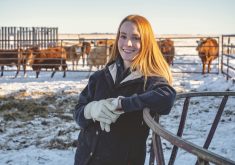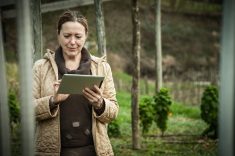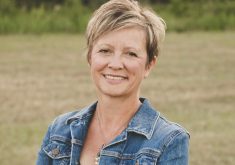If it has been a challenge to convince more women to be open to a job on the farm, it isn’t only because of the attitudes and biases that can seem — especially to non-farmers — to be inherent in agriculture itself; there are also a host of practical issues that any woman who is considering taking a job on your farm will somehow have to sort out, especially if the role has always been done by men in the past.
“There are things like making sure that you have access to clothing that is for women, work boots that are for women and gloves that fit women’s hands,” says Jennifer Wright, acting executive director on the Canadian Agricultural Human Resources Council. “These things are not always accessible or in stock … that’s an area that still continues to need improvement.”
In the bigger picture, too, access to rural daycare hampers many women from entering the farm workforce, especially since many jobs on the farm aren’t nine-to-five and may need more flexible daycare arrangements than many daycares provide.
Read Also

Building a farm legacy that outlasts you
A farm’s legacy isn’t just about the land; it’s also about the values and the impact that continue long after the current owner has stepped away.
“Not everybody has family to lean on in those cases,” Wright says.
Also on the topic of children, while parental leave is increasingly being taken by both women and men, there are still inequities in the workplace around maternity leave for women and even hiring decisions based on potential family responsibilities.
Will a female applicant think it’s smart to take a job with you?
“There may still be a bit of a bias when they are looking at hiring a woman about the potential for them to take time off for pregnancy, or having family responsibilities,” Wright says. “When hiring, they might not always be looking at the candidates equally.”
Opening the door to women
Ana Maria Ayala Arboleda knows what it’s like to be a female farm employee. She has worked in the swine industry in her native Colombia (where she trained as a veterinarian) and in Canada, and says that in the early days of her career she experienced skepticism in both countries about her ability to work in a traditionally male-dominated sector.
“When you went to a barn or to see a producer, they thought that you wouldn’t know how to handle a pig because you weren’t a man, and they assumed that you didn’t have any background (in the industry),” she says.
Ayala works for Hypor Inc. in Ituna, Sask. She had wanted to learn more about the production end of the pork sector when she heard about the job opportunity with the company and moved to Canada two years ago.
“They were looking for people to work in their nucleus barn, the largest pork barn, and I applied because I wanted to get in touch with the production and the animals … how do you handle them, their behaviour,” she says. “This is definitely an opportunity for me to get that extra knowledge and apply it in the future.”
With labour shortages in ag already well documented and getting worse, the assumption is that more farmers will want to hire more women like Ayala. But will they actually follow through?
With agriculture coming late to the party, it won’t always be easy. “We’ve got to a crisis point, but so have other industries, which has only increased the competition for a smaller labour pool,” Wright warns.
Even so, she’s optimistic. “We’ve seen more women entering the industry and now there’s even more opportunity.”
It’s also meant that employers are starting to be more open to trying new things and maybe even giving things they have tried in the past another chance.
“An employer might have an unconscious bias, or a conscious bias, about what a female employee might be able to do from a physical labour point of view,” Wright says. “But, when they are looking for an employee today, and have a female candidate that demonstrates that they can do the work, if they had that bias, they may think about ignoring it.”
Women more likely to apply
A lot has changed in terms of women’s roles in agriculture over the last 10 years, and a big shift has been that women see themselves as suited for all kinds of jobs that have always been thought of as the preserve of their male counterparts. As a result, they are more likely to apply for those jobs today than a few years ago, when they believed their application would get passed over for a male candidate.
“Whereas women may have thought they could do the work before, but they didn’t apply because they didn’t think they’d be looked at, now women, more and more, are applying for the jobs that they know they can do,” Wright says.
That doesn’t mean that women see themselves as necessarily doing a job in the same way as men, but they are more confident today that they can find solutions to ensure that they can do the job as well.
After starting out in the farrowing area, Ayala progressed to the nursery and now works in finishing with the largest animals and has never doubted her ability to master each role.
“I felt challenged at the beginning but now I feel that it’s just another experience,” she says. “You just need to be able to assess yourself, be resilient about the environment that you’re working in, and find your way to do things to achieve the outcome that is required.”
Gender gap still exists but is getting addressed
Ayala is fully aware of the gender gap that still exists in agriculture, but she feels it’s getting better and employment opportunities for women are going to continue to increase as women continue to demonstrate their value to the industry.
“Although women may be in lower positions, or their wages are not as good as men who are in higher positions sometimes, I feel that women push themselves harder to do the best job that they can,” says Ayala. “I don’t let (being a woman) be a limitation to try to get a higher position, because we, as women, will work to show that we have a lot of value. Women have to evaluate themselves, and believe that they do not have limitations. We are smart and good at troubleshooting, and this is where we can find good opportunities.”
Generational differences are also creating a shift in attitudes around gender and equity. Younger men and women coming into the ag workforce have far different attitudes and expectations than their parents or grandparents.
“We’ve seen a real shift, especially since the pandemic, where many people regardless of gender are looking at work in a different way, and they’re starting to look for better work/life balance,” Wright says. “Certainly, we’re seeing the younger generation of fathers, for example, wanting to take their parental leave and be part of the child care process. That’s had an impact because it’s not just about women; it’s more generational, and with a labour crisis hitting across many industries, it’s becoming harder for employers to ignore that.”
Job seekers in the driver’s seat
Job seekers are definitely in a strong negotiating position. “If there is a situation with an employer that isn’t going to meet what an employee is looking for, they know that they can move on,” Wright says. “Employers have to be more flexible and they are starting to work that way in all sorts of areas.”
That includes things like allowing employees (of any gender) to leave earlier or arrive later so they can pick up or drop off children at daycare, or making work shifts accommodate family situations.
“The employers that are looking at ways to make some accommodations are going to be the ones that will attract more people to come and work for them, and will have better retention in the future,” Wright says.
Valeska Ferl understands that dynamic well. Originally from Germany, for the past 10 years Ferl has worked at Halarda Farms Ltd. at Elm Creek, Man., one of Manitoba’s largest dairies that milks more than 1,200 cows a day. She does milking shifts but also helps in other areas, such as cow management and health. She believes that it doesn’t matter what gender you are; today you can get a job in agriculture if you are prepared to work hard.
“It depends what you are looking for,” she says. “But you have to be a flexible person. When I worked at the other farm, I did hiring interviews and from the employer’s side, it’s very hard to get reliable people.”
Women taking more training
Today, two-thirds of the people working in the barns at Halarda Farms Ltd. are female, a big change from 10 years ago.
It’s one more indication that more women are looking for and finding jobs in the industry and that they are taking the training they need to do the work.
“I know from my friends, even if they are operators on a grain farm, there are more and more women that are focused on education to be able to do those jobs as well,” Ferl says. “Everything is more open today. Nobody is looking at you and saying you can’t drive a tractor if you didn’t start doing that when you were 10 years old. If an employer says ‘can you handle the work we are asking you to do,’ and you say ‘yes’, it doesn’t matter what gender you are, you will get a chance to prove it because there is a need for people who are willing and able to work.”
That commitment to extra training is something Ferl believes in strongly. She has a Canadian class one driver’s licence, which she took initially to help out a friend working on a grain farm, but she also did it because sees it as a good job skill.
“I wanted to prove to myself that I could do it,” Ferl adds. “I like the idea of having an extra qualification … it opens up quite a few more job options.”
















